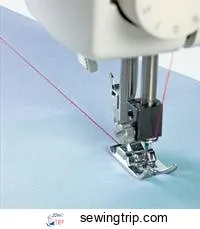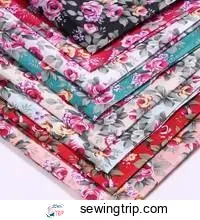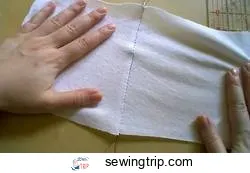This site is supported by our readers. We may earn a commission, at no cost to you, if you purchase through links.
If you’re functioning with polyester for the very first time, you’ve unquestionably mosting likely to have some inquiries regarding just how to use it. What stress do you require on the sewing machine, what needle size should you use, and even (and this is the big one) can you sew it at all?
Table Of Contents
- Can You Sew Polyester?
- Sewing Polyester Tips
- Sewing Machine Settings for Polyester
- What Tension for Sewing Polyester
- What Size Needle to Sew Polyester?
- Sewing 100 Polyester Fabric
- Sewing Polyester as well as Spandex
- Can you Sew Cotton as well as Polyester Together?
- Can You Hand Sew Polyester?
- How to Sew Polyester by Hand
- Sewing Polyester Without Puckering
- Best Stitch for Hemming Polyester
- Can You Sew Ripped Polyester?
- Do You Need to Wash Polyester Before Sewing?
Can You Sew Polyester?
We’ll pertain to the other questions soon, yet in respond to the last one, it’s a yes …
Polyester is one of one of the most frequently utilized synthetics. As it’s a plastic substance, it can melt and also fuse under high heats up, making it the best product for creating non-woven materials like felt, along with both woven and also weaved polyester materials.
Given the huge variety of different appearances as well as weights polyester can be found in, knowing the best sewing method for it can be difficult: what jobs best for one kind of polyester textiles can be inefficient on one more.
There are, however, some strategies and also considerations that function throughout the board. Despite the sort of polyester fabric you’re utilizing, continue reading for some valuable little ideas that will certainly ensure success.
Sewing Polyester Tips
- Wash prior to usage.
Prior to you start to even take into consideration threading a needle, wash the polyester item in cold water and also dry on a low warmth. This will make certain no excess colorants or layers interfere with the sewing
- Utilize a fresh needle.
Polyester is composed of tiny fibers that can snag and also tear quickly: prevent creating any damage by shunning worn or utilized needles for a fresh one. Polyester materials likewise tend to react better to smaller needles- opt for a bigger needle, and also you run the risk of compromising the joint and also triggering big, unattractive holes in the material.
- Make use of polyester thread.
When picking a thread, it’s best to use one that matches the flexibility of the textile you’re sewing as carefully as feasible. What much better string to utilize for polyester, after that, then polyester thread?
While making use of polyester thread for hand sewing is unproblematic sufficient, there are a couple of little information to be familiar with when utilizing it for machine sewing Wind the bobbin slowly, and also keep the sewing to a slow-moving, even rate. Feeding the string too rapidly can produce enough friction as well as warm to make the thread stretch. As it cools down, the string will diminish as well as number the seams.
- Iron layer lines prior to sewing
Before you begin removing pattern items, iron the material utilizing an artificial setup. If any folds can’t be eliminated with ironing, remove the annoying section prior to going any kind of further.
- Treat satin polyester with care.
Satin polyester can be unsafe. Make life simpler for on your own by fixing the cut-out fabric pieces to cells documents or computer paper before you start to stitch. The secure support this develops will certainly quit the material moving around under the needle.
Sewing Machine Settings for Polyester
If you’re brand-new to sewing with polyester (or new to sewing in general), keep in mind you’ll need to adapt your typical sewing style to satisfy its specific demands. When it pertains to the suggested sewing machine setting, stick to a stitch size of 0.5 millimeters (0.020 in) to 1.5 millimeters (0.059 in) for the best results.
You’ll likewise need to readjust the foot pressure. Excess stress will make the machine pull the material as you sew it, leading to puckering. Maintain your seams plant by maintaining to a reduced pressure.
What Tension for Sewing Polyester
The inquiry of what stress to use for sewing polyester can be a tough one to respond to, as there are numerous variables involved. The good news is, you do not require to believe way too much regarding it — established up your machine for polyester, and it will certainly deal with a lot of sorts of poly textiles without additional modifications being required.
As a general policy of thumb, the upper stress will generally be around a 4. If you’re unsure if you’ve set the machine correctly, test out a couple of stitches on some scraps before starting.
What Size Needle to Sew Polyester?
If you’re sewing polyester, be careful to pick one of the most suitable needle. For machine sewing, the needles suggested are 70/ 10-80 / 12 ballpoints, sharps, as well as stretch depending upon the textile framework as well as weight. If you’re sewing by hand, it’s advised to utilize needles in sizes 5-10
Sewing 100 Polyester Fabric
Fabrics made from 100% polyester have a variety of unique benefits: as well as being stain-resistant, they can conveniently be boosted with long-term pleats and patterns. However, they have a tendency to be among the least breathable textiles out there (which is why they’re usually combined with cotton to make a poly-cotton blend).
If you’re working with 100% polyester, the most crucial point to keep in mind is to use a high quality polyester string — a cotton string will merely not match the stretch and also longevity of the material itself, as well as you’re most likely to experience problems down the line.
Sewing Polyester as well as Spandex
The elastic nature of spandex and also polyester can make it an obstacle to sew. To make the task a lighter one, the adhering to overview must provide some inspiration.
Action 1
Preparation is essential. Spandex has a tendency to shrink the very first time you wash it- prevent the threat of winding up with a 2-sizes too-small garment by cleaning on a trendy laundry prior to you start removing the pieces.
Step 2
When the material has actually been cleaned and also dried out, use sharp scissors or a rotating cutter to cut out the items. If you’re making use of a rotating cutter, place the textile on a cutting mat prior to starting.
Action 3
Usage ballpoint pins (their rounded pointers will certainly keep the material from cutting) to pin the material along the seam allocation.
Action 4
Using your hand, tug the spandex to learn which method it stretches (a 2-way stretch material will certainly stretch flat, while 4-way stretch fabric will extend both horizontally and up and down). Make certain you position the textile to ensure that it extends around the body, instead of along its size.
Action 5
Set your sewing machine with a ballpoint needle, which is much less most likely to damage the fibers of the product than a regular needle.
Action 6
As excessive stress on the pressure foot can result in puckering, make any changes necessary before you begin to sew.
Step 7
Thread your machine with a versatile polyester string in a shade that matches your textile.
Step 8
Establish the machine to a narrow zigzag stitch as well as readjusting the stitch size to. 5 millimeters.
Tip: Resist the urge to draw the material as you sew. While this method deals with a lot of products, it’s likely to lead to puckering if you try it on spandex. For the very same factor, prevent letting the textile drape over the side of your work surface area.
Can you Sew Cotton as well as Polyester Together?
Usually, it’s not a good idea to sew all-natural textiles with artificial threads (and also vice versa) as they need a different kind of string. Wherever feasible, cotton needs to be stitched with cotton string, as well as manmade fibers like polyester ought to be stitched with polyester string. The reason for matching like for like is simple: polyester string is more powerful than cotton, and over time, can weaken cotton’s fiber. Likewise, cotton thread won’t be strong sufficient to tackle the challenge of a polyester material.
If you’re making use of a poly-cotton mix, sewing needs to be relatively easy, although it’s suggested you stay with making use of a polyester string over a cotton one.
Can You Hand Sew Polyester?
While sewing polyester with a machine is the most convenient technique of collaborating with polyester, if you have not obtained one, all’s not lost — although hand sewing may be even more of a difficulty, it’s still feasible.
How to Sew Polyester by Hand
While sewing polyester by hand can be difficult to master, there’s some methods of the trade that ought to see you via.
- Laundry before use to eliminate any type of coloring or layer that’s on the textile.
- Polys (specifically silky ones) are slithery. You can make them more workable by spraying them with starch prior to you start to stitch (although remember to wash the garment once more before wearing to get rid of the product build-up).
- Make use of a ballpoint needle in sizes 5-10 and also a good top quality polyester thread.
- Stitch utilizing a tiny, really narrow zigzag– try to make the zig-zag so narrow, it’s virtually a straight line.
Sewing Polyester Without Puckering
If you’re sewing with satin polyester, you may discover yourself having a hard time maintaining it from tightening. Even the most seasoned sewer can experience the same trouble, however fortunately, there’s a couple of points you can do to decrease the feared crease.
- Experiment. Purchase sufficient material to give you plenty of scraps to check out the various needle dimensions, stitches, tensions, etc. By the time you concern sew the fabric for genuine, you need to currently have adequate experience under your belt from your experiments to know what sewing technique will certainly function best
- Don’t be lured to utilize any old needle. Polyester works best with as great a needle as possible– a size 8 “Sharp” or “Microtex” needle is among the best to attempt.
- Use little, slim zigzag stitches to stitch the seam.
- Lay the items on the cross-grain instead of lengthwise.
- Reduce the pressure on the sewing machine Excessive stress will pull the material as you sew it and also result in puckering. Reduced the stress prior to you begin sewing for the best opportunities of success.
Best Stitch for Hemming Polyester
The delight of polyester is that it has some stretch — while this may make it really suiting after a huge lunch, it does indicate you have to adopt a slightly various method to hemming to what you might be utilized to. First of all, it’s always suggested to make use of a zig-zag string when hemming. Use that, in addition to this action by step process, for guaranteed success.
Step 1
Using a zigzag or overlock sew, sew the raw side of the textile to quit it from extending or fraying.
Action 2
Hang vertically for 24 hrs to enable the material to extend to its proper length prior to you begin to hem.
Action 3
Define the hemline with a material pen — ideally, ask somebody to do this for you while you’re putting on the garment.
Step 4
Iron the fabric on a reduced setup and pin the hem in location with ballpoint pens.
Action 5
Insert a twin needle right into the sewing machine as well as string the needles. Wind the bobbin with polyester thread and also put the bobbin. Set the stitch readying to 3-3 5 sew per length.
Action 6
Slowly and thoroughly begin sewing about. 5 inches far from the hemmed edge. As you sew, be careful not to stretch the material. Eliminate the pins to complete.
Can You Sew Ripped Polyester?
Although it’s recognized for its sturdiness, polyester can sometimes tear if it’s placed under adequate stress and anxiety. While you’ll not be able to restore the garment to its original condition, repairing the torn sides will at the very least give you a garment that’s still functional.
Action 1
Acquisition a little piece of polyester fabric that’s as close a match to the color as well as weight of your torn garment as feasible.
Action 2
Cut a piece of the acquired textile to size. It ought to be 1 inches larger in both size and also width than the tear.
Step 3
If the torn garment is lined, obtain the lining near the tear utilizing a joint ripper, and push the lining far from the tear.
Step 4
Placement the new item of fabric beneath the tear on the within the garment. Pull the broken edge with each other as well as pin the piece of textile to the garment.
Step 5
Set the machine to a broad zigzag stitch as well as numerous plant lines over the tear to ensure it holds.
Action 6
Cut the threads, and afterwards cut away the excess of the brand-new material beneath the tear. Leave around. 75 inches remaining around the sewing. Remove the pins.
Action 7
Slide the lining back in the area and also pin. Utilize a hand slip-stitch to deal with the lining completely ready.
Do You Need to Wash Polyester Before Sewing?
While polyester isn’t the easiest of textiles to stitch, prepping the material properly prior to you start can remove a whole lot of the hardship. Among the vital items of prep is to clean the material in great water beforehand. This will make certain any kind of coverings as well as coverings are removed prior to you start sewing
Ideally, you’ve grabbed sufficient pointers as well as tricks to make your next poly-project a breeze. If you feel any of the suggestions might be helpful to your fellow crafters, please really feel totally free to share the message.









